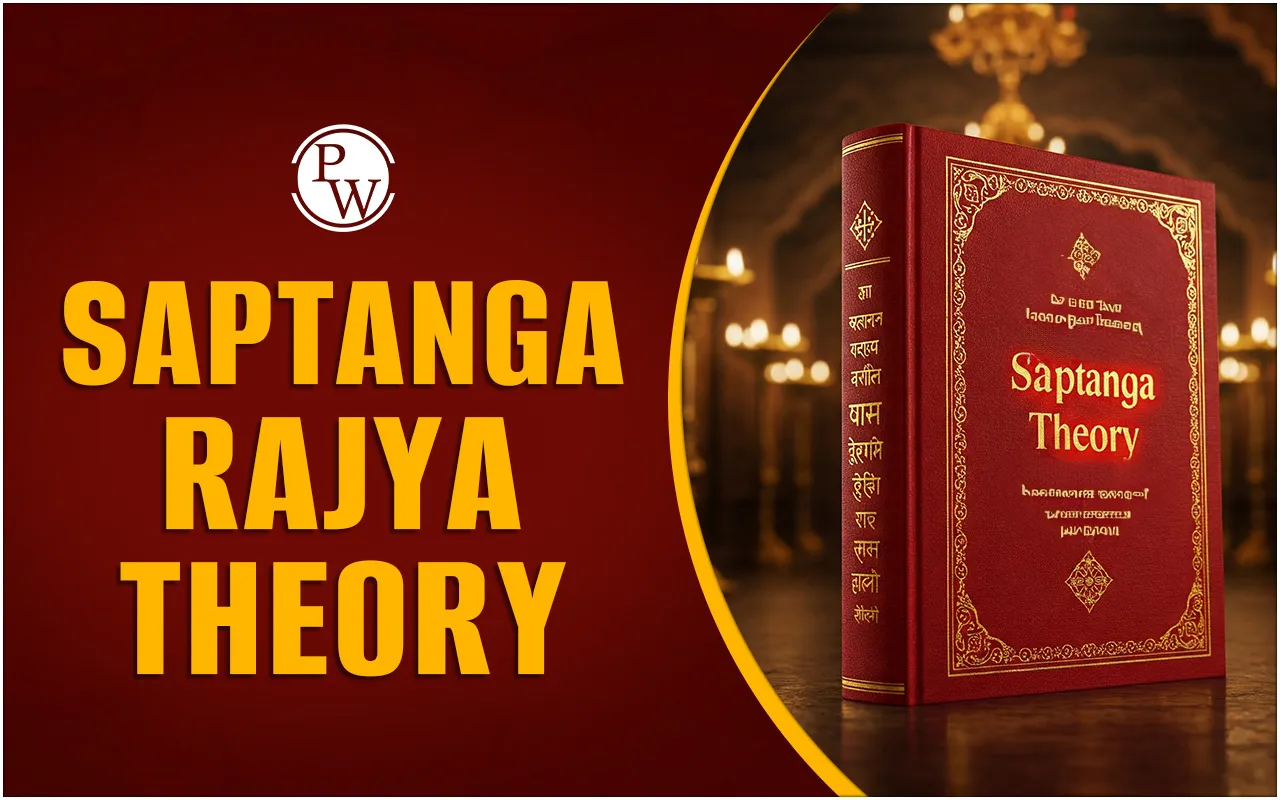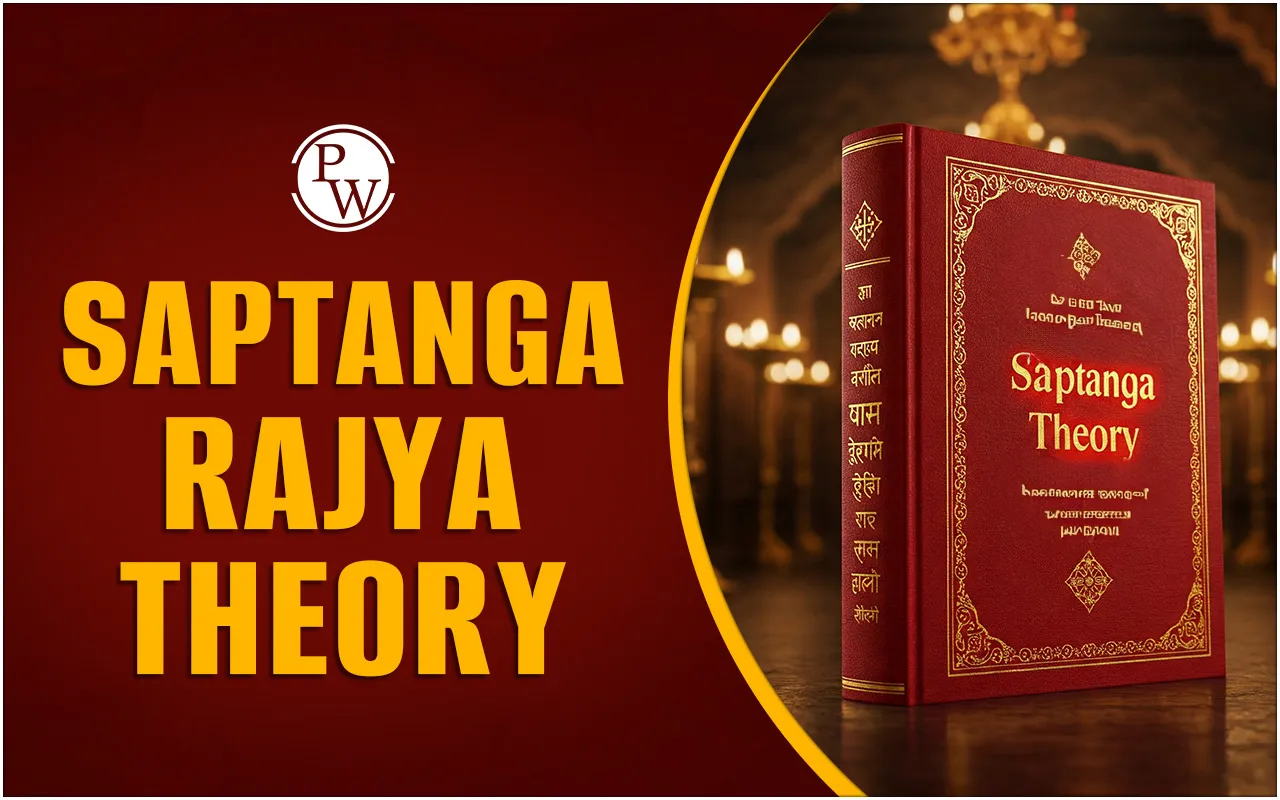

Saptanga Rajya theory or the Saptanga theory of state, developed by the ancient Indian political thinker Kautilya (also known as Chanakya), outlines the seven essential elements of a well-governed state. These elements, or "limbs," are the king, ministers, territory, fort, treasury, army, and allies.
About Saptanga Rajya Theory
The theory emphasizes the interconnectedness of these elements for a state's stability and prosperity. The Saptanga Rajya theory emphasizes that a state's strength and success depend on the proper functioning and balance of all these elements. Kautilya believed that a state that neglects any of these elements is vulnerable and prone to instability. For example, a weak army or a poorly managed treasury could weaken the state's ability to defend itself or provide for its citizens.
The Arthashastra is the first South Asian work to provide a view of the state as a collection of seven parts. Kautilya's notion of Saptanga Rajya theory describes the State as a system of seven interconnected elements (angas or prakritis). The concept of saptanga-rajya was embraced in later writings such as the Dharmashastras, Puranas, and Mahabharata, with minor alterations.
Seven Elements of the Saptanga Rajya Theory
These seven elements were in the following order:
| Seven Elements of the Saptanga Rajya Theory | |
| Svami | The King |
| Amatya | Ministers |
| Janapada | Area and its subjects |
| Durga | Fortified capital |
| Kosha | The Treasury |
| Danda | Justice, power |
| Mitra | Ally |
Svami
The Arthashastra teaches that monarchy is the norm and focuses on the king.
-
Kautilya believed that the king's fate was inextricably linked to that of his subjects. If the king was energetic, his subjects would also be energetic. If he was indolent, his citizens would follow suit and deplete the kingdom's resources. Kautilya called for an alert, vigilant, and wise king.
-
Ashoka's inscriptions closely align with Kautilya's concept of kingship. According to his Minor Rock Edicts, Ashoka referred to himself as the raja of Magadha, rather than the more prestigious titles of subsequent periods such as maharaja or maharajadhiraja.
-
The favorite epithet in the inscriptions is 'Devanamapiya' or 'beloved of the gods', indicating a heavenly connection. In Rock Edicts I and II, Ashoka established a new 'paternalistic kingship' by declaring 'All men are my children'.
-
He emphasized the importance of ensuring the wellbeing of all beings and subjects, both in this world and the next, as part of his kingship principles.
Amatya
The term 'amatya' referred to high-ranking officials, counsellors, and department heads.
-
The Arthashastra describes two types of advisory bodies. The mantra-parishad was a minor advisory committee made up of ministers. The mantri-parishad was a broader body that included all department executive chiefs.
-
The purohita played a vital role in Kautilya's administration. The Mauryan 'Empire' included royal priests. According to the Arthashastra, a purohita must come from a reputable family and be well-versed in Vedas, divination, and politics. Kautilya's salary figures can be used to determine the importance of the purohita.
-
According to Kautilya, the highest officials were highly compensated, with the chief minister, purhoita, and army commander earning 48,000 panas, and the treasurer and chief collector receiving 24,000 panas.
-
Kautilya's estimations suggest that higher-level administration personnel were highly compensated, accounting for a significant portion of the overall cash collected.
Janapada
This referred to a recognized territory known as the realm of the empire.
-
The Janapada was a significant source of income for the king. The book highlights the State's efforts for maximizing tax revenue through agricultural development, including investments, rewards, and penalties.
-
The king's focus on trade routes and port cities suggests a strong economic interest in his kingdom.
Durga
Fortified cities play a crucial role in defending the realm by protecting border regions, providing refuge during attacks, and housing the state's main economic and administrative centers.
-
The Arthashastra ideal state includes multiple strongholds, each with a unique location and purpose.
-
The capital city, the largest of the fortifications, serves as the kingdom's administrative, economic, and military hub. According to Kautilya, the fort should be built with mud ramparts and parapets made of brick and stone. It should also be well-stocked with grain and needs in case of siege. Interestingly, Greek records mention Pataliputra, the Magadhan capital, on a large scale.
-
Kautilya also proposed stationing troops at the fort. He describes a standing army with four primary divisions: infantry, cavalry, chariots, and elephants.
-
According to Ashoka's edicts, following the Kalinga war, he embraced nonviolence and focused on dhamma-vijaya (winning via dharma) above fighting. However, he did not disband the army.
Kosha
A strong economy is crucial for the State's survival, regardless of the conditions. Ancient Indian philosophers considered treasury a crucial part of the state.
-
Kautilya aimed for a flourishing treasury, but instructed the monarch to obtain the nation's wealth through legitimate and virtuous means, rather than unjust or immoral ways.
-
Kautilya proposed four legal revenue sources: (i) land taxes, (ii) market duties, (iii) import and export taxes, and (iv) miscellaneous taxes.
Danda
Danda can be interpreted as referring to force or justice.
-
The Arthashastra provides a detailed description of the judicial system, including dharmasthas (judges) and pradeshtris (officers who repress criminals). Punishments for offenses and crimes included fines, mutilation of limbs, and even lethal punishment.
-
Kautilya believed that punishment was determined by both the nature and intensity of the offense, as well as the offender's varna. Kautilya imposed lenient punishments for higher varnas for similar crimes. For instance, if a kshatriya engaged in sexual contact with a brahmin woman, he would face the greatest fine.
-
A vaishya's entire property may be taken for committing the same offense. The worst punishment was reserved for shudras.
-
According to Ashoka's inscriptions, the city mahamatas were responsible for judicial matters.
-
The edicts exhort mahamatas to be impartial and not detain or punish anyone without sufficient evidence. In Pillar Edict IV, Ashoka claims to have brought samata into judicial procedures. Some readings suggest that he established a consistent system of law and eliminated varna disparities in punishments.
Mitra
This element alludes to political allies or 'friends' of the realm. Kautilya's polity revolves around the vijigishu, or would-be conqueror.
-
The inter-state policy revolves around three key players: the ari (enemy), madhyama (middle king), and udasina (neutral king).
-
According to Kautilya, the king might use various policies and methods depending on the situation, such as a peace pact (sandhi) for a greater opponent or animosity (vigraha) for a weaker enemy. Other choices included military expeditions or collaborating with the adversary to attack jointly.
-
Ashoka despatched embassies to Hellenistic kingdoms in the northwest to improve trade relations. The Mauryan alliance with the Seleucids dates back to a pact signed by Chandragupta. Diplomatic exchanges persisted with future rulers.
-
Ashoka mentions several contemporaries with whom he shared missions. His inscriptions reference Greek ruler Amtiyoga and the regions of Tulamaya, Anetika, Make, and Alikyashudala.
-
Historians have identified Antiochus II of Syria (260-246 BCE), Ptolemy II Philadelphus of Egypt (285-247 BCE), Antigonus Gonatus of Macedonia (276-239 BCE), Magas of Cyrene, and Alexander of Epirus. Ashoka sent special ministers to frontier regions and neighboring realms to promote Dhamma and Buddha's teachings.
Also Check, Purusharthas in Hindi Religion
Conclusion
The Saptanga Rajya theory presents a holistic framework for understanding the structure and functioning of an ideal state in ancient Indian political thought. By dividing the state into seven key constituents—Swami (the ruler), Amatya (the ministers), Janapada (the territory and population), Durga (the fortified capital), Kosha (the treasury), Danda (the army), and Mitra (allies)—the theory allows for a nuanced assessment of governance. Each element is defined by a set of ideal attributes, emphasizing not just their individual importance, but also their interdependence.
Saptanga Rajya TheoryFAQs
What is the Saptanga Rajya Theory?
Why are the seven elements important for a state?
How does the Saptanga Rajya Theory relate to modern governance?
How does the theory emphasize the importance of the army and treasury?
What role does the king play in the Saptanga Rajya Theory?













